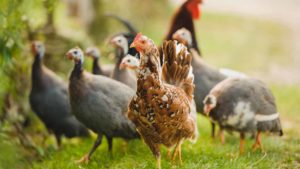
Across the US and in many other parts of the world, adding guinea fowl to your ranch, farm, hobby farm, or homestead is gaining in popularity. Although guinea-keeping lags behind chickens, turkeys and ducks, people are discovering the advantages of keeping guinea fowl as their sole flock or adding them to their existing poultry flocks.
Guinea fowl were somewhat common on farms across the US in earlier times, but as farms became more single-purpose, their numbers waned. Now, however, guineas’ usefulness for pest control and as early warning systems for other poultry has begun to earn them a place on the farm once again.
The type of guinea fowl we’re focused on is known as the Helmeted guinea fowl, Numida meleagris. There are six other species of guinea fowl, but Helmeted are the best known and are the ones that have been widely introduced as a domesticated species. Although some people keep guineas for meat or egg production, the information contained here will be more helpful to people keeping guineas as described above, for pest control and to help protect their existing flocks.
Most of us didn’t grow up with guinea fowl, and people who already have experience with chickens or turkeys find that guinea fowl don’t follow the same rules.
And because guinea fowl are not a commercial bird, they haven’t been well studied. There is a lot of information in various books and online, aimed at filling in that gap in information about guinea keeping, unfortunately much of it incorrect or misguided. Some sources have simply adopted guidelines for raising chickens, and substituted “guineas.” Others have based their information on what they remember their grandparents having done. And still others just pass along techniques that have “always worked for me,” without regard to the different kinds of environments, climates, predators, and parasites that you might encounter.
The information we’ve collected comes from the experience of some of the largest guinea-hatcheries, from university poultry science departments, from the few studies that have involved guinea fowl, and from some of the largest and most experienced guinea-keepers, both commercial and backyard flocks, in the US, Europe and Australia. In addition, we’ve collected information from the tens of thousands of guinea-keepers who post on our social media pages.
This booklet is meant to help you be a successful guinea-keeper: To help you understand them for the unique animals that they are; accommodate their needs and take advantage of rather than fight their instincts; and get as much benefit and enjoyment from guinea-keeping as we do.
Every flock is different, just as every situation is different, but we offer guidelines and methods to give you the best chance for success. As you get to know your flock and begin to become a bit of a guinea-keeping expert, you’ll know better when to bend the “rules” and apply methods that work for you.






